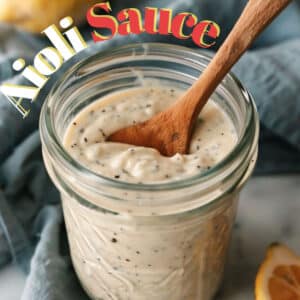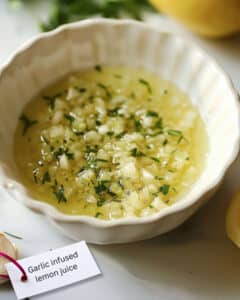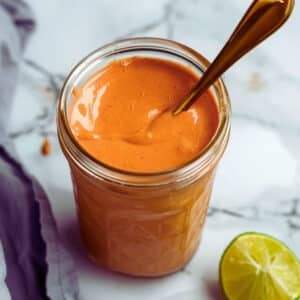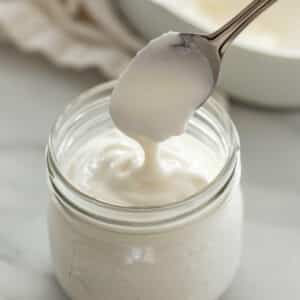Lemon aioli transforms simple ingredients into a luxuriously creamy sauce that'll elevate everything it touches. With just a 5 minutes and a handful of ingredients, you can ditch those store-bought jars and whip up the most flavorful aioli you've ever tasted. Drizzle it on grilled fish, spread it on sandwiches, dip your veggies in it – the possibilities are endless!
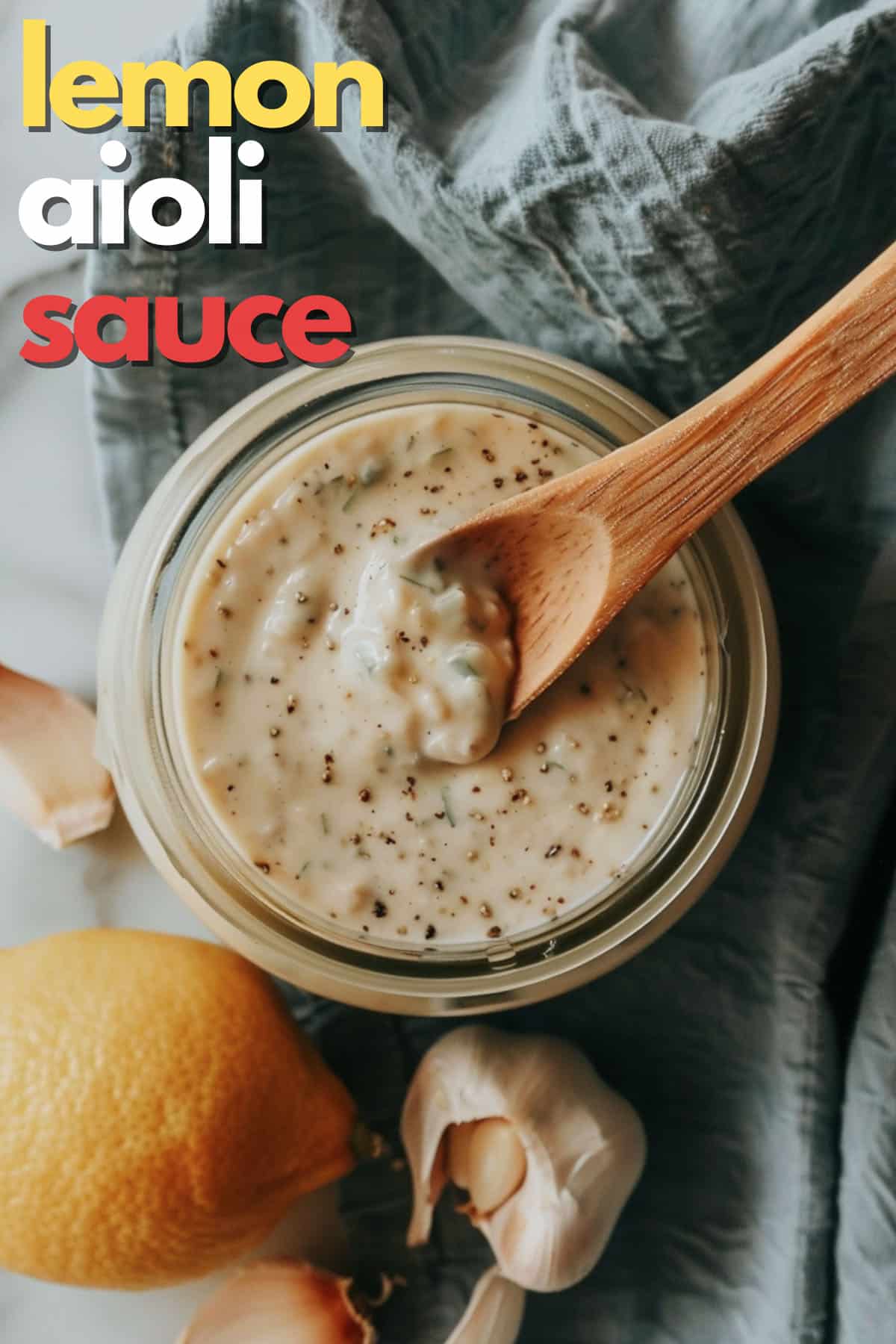
Ingredients You'll Need
- ½ cup mayonnaise: Forms the rich, creamy base of the aioli. The emulsification of oil and egg yolks in mayonnaise creates the ideal foundation for building upon.
- ½ cup sour cream: Adds a delightful tanginess that complements the lemon and cuts through the richness of the mayonnaise. Its subtle acidity also helps brighten the aioli's flavor.
- 1 tablespoon olive oil: Enhances the luxurious texture of the aioli and contributes a subtle fruity note. Opt for a good-quality olive oil for the best flavor.
- 1 large lemon, juiced and zested: The star of the show! The juice provides a vibrant, acidic punch, essential for balancing the rich flavors. Zest adds a layer of intense lemon aroma and a slight bitterness that adds complexity.
- 1 tablespoon minced garlic: The pungent, savory backbone of aioli. Garlic's intensity is crucial; don't be tempted by pre-minced garlic, as it lacks the same freshness and flavor.
- ½ teaspoon salt & ½ teaspoon ground black pepper: The essential seasoning duo. Salt heightens all the existing flavors, while pepper adds a touch of warmth and bite.
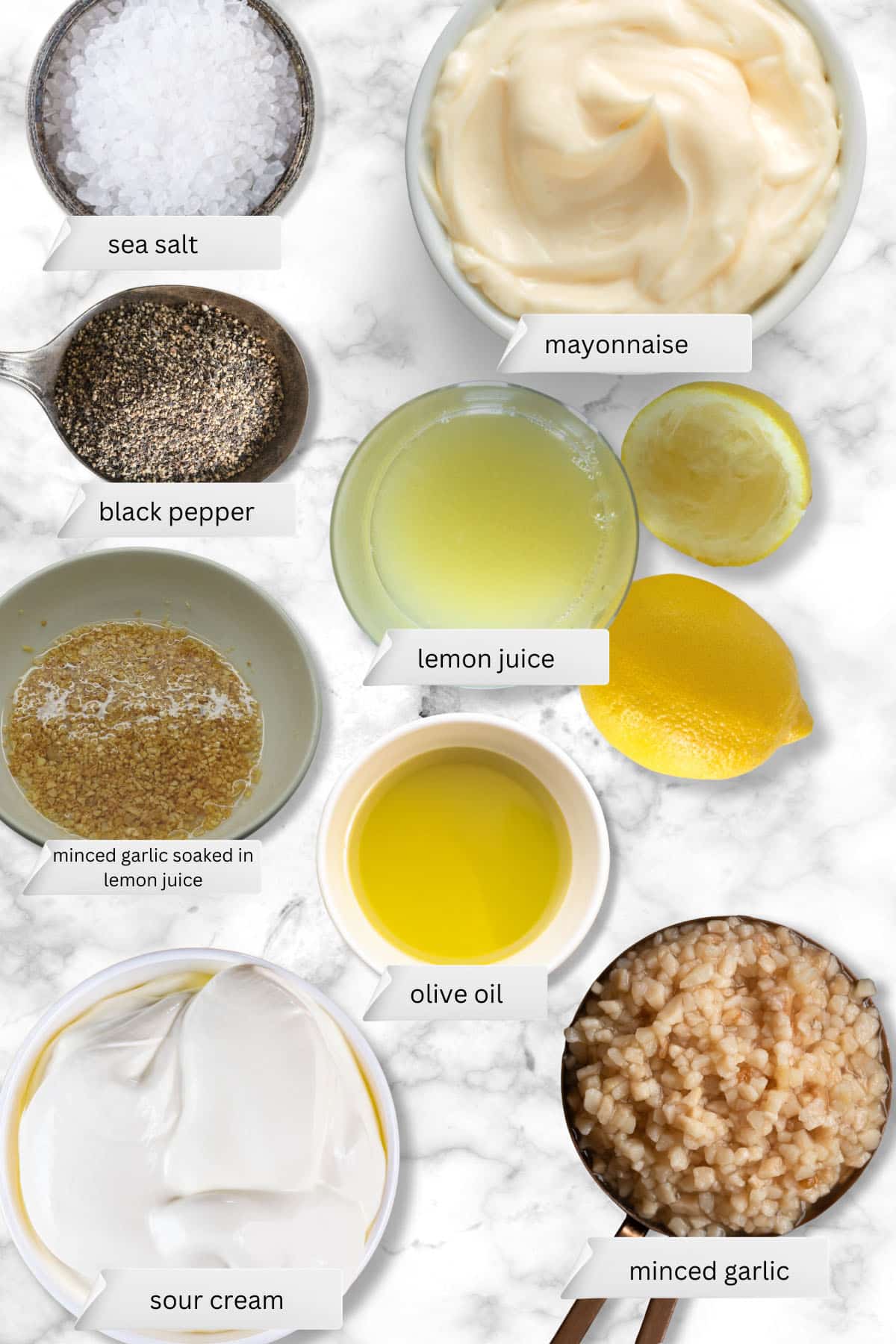
Important Notes
- Fresh Ingredients: It cannot be overstated: fresh lemon and garlic are non-negotiable. Bottled lemon juice and pre-minced garlic will result in a vastly inferior aioli.
- Tasting & Adjusting: The "salt and pepper to taste" is key. Everyone's preferences differ, so taste as you go!
Step-by-Step Instructions
Flavor Infusion.
Basically, we're going to jazz it up with a little trick. First, soak some minced garlic in lemon juice for about 10 minutes. This mellows the garlic's bite and gives it that classic aioli flavor.
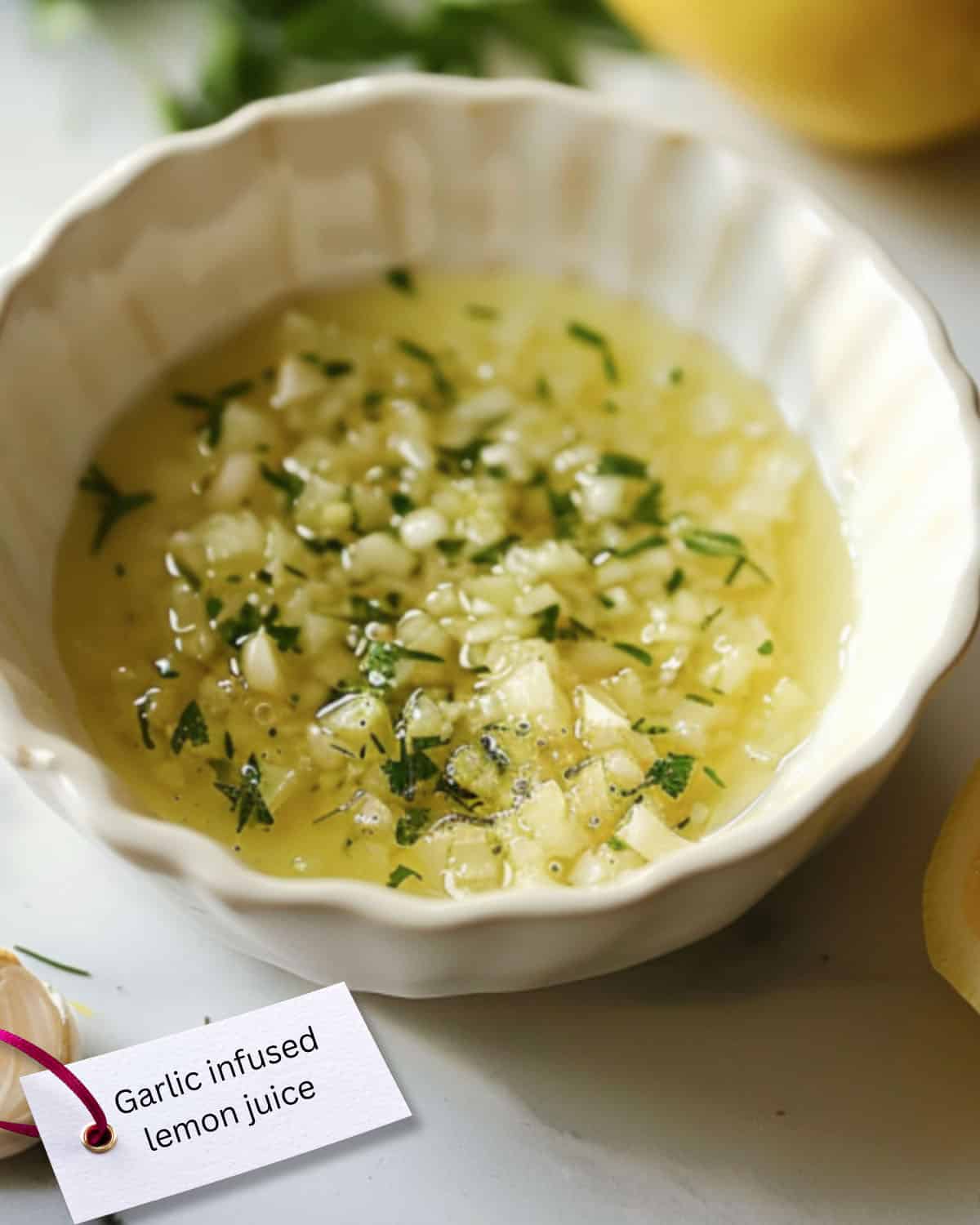
You know why? Think of it like making garlic-infused oil, but with lemon juice! Soaking the minced garlic mellows its harshness (here's the science behind it) and infuses the lemon with a delicious garlicky flavor. This means you get all the aioli goodness without those little bits of raw garlic that can become overpowering.
Strain for Smoothness.
Strain the garlic from the lemon juice. While it might seem like an extra step, trust me, the result is a luxuriously smooth aioli without any overpowering garlic bits. The lemon juice is still infused with all that delicious flavor!
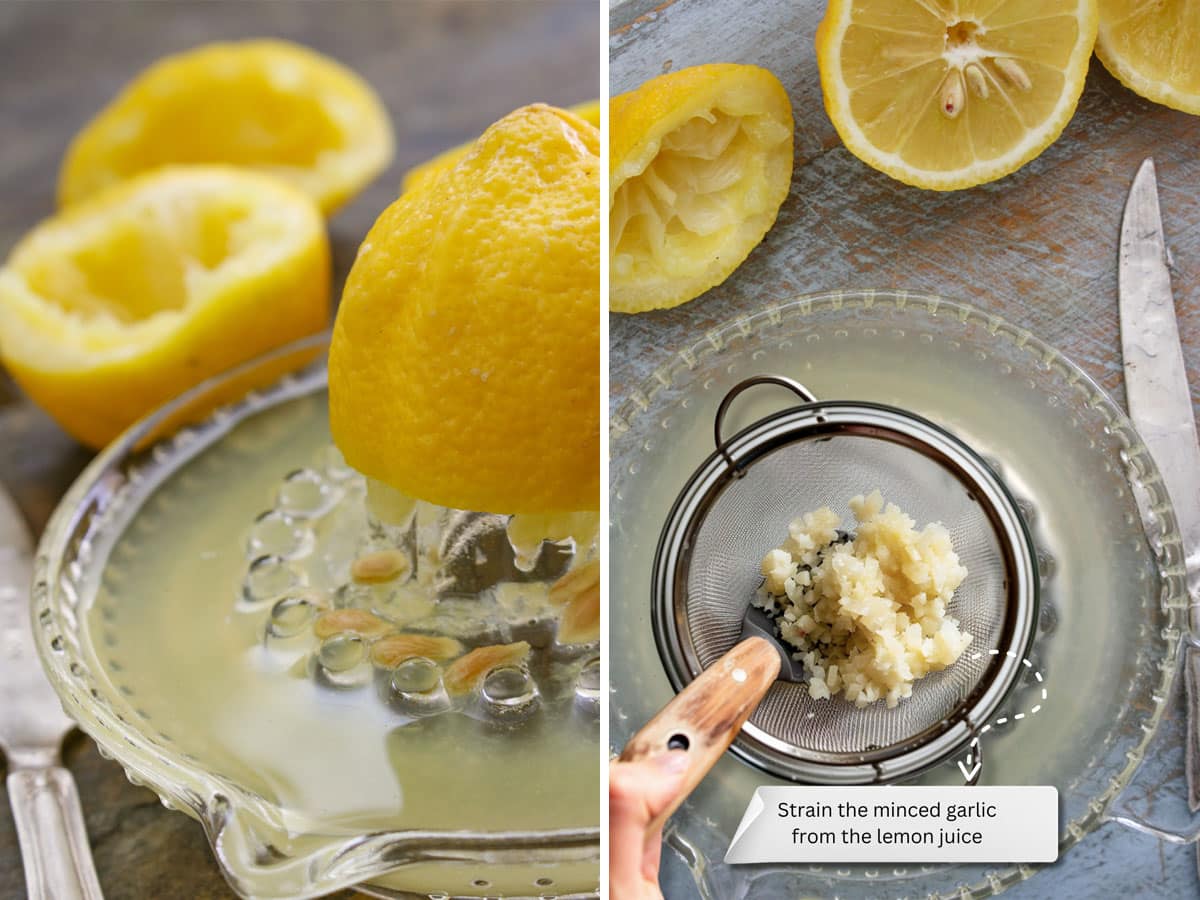
Time Saver: In a pinch? You can skip the garlic and whisk the plain lemon juice directly into the mayonnaise. However, you'll lose that subtle garlic complexity.
Create the Creamy Base.
In a medium-sized bowl, combine the mayonnaise, sour cream, and olive oil. Whisk these ingredients together until smooth and well-combined.
Gradually whisk in the strained, garlic-infused lemon juice. Start with a tablespoon or two, whisking vigorously, then slowly add the rest. This helps the mixture emulsify properly, creating a silky-smooth aioli.

Seasoning and Tasting - The Art of Balance.
Now comes the magic – creating your perfect aioli flavor profile! It's all about balancing the richness of the mayonnaise and sour cream with the bright acidity of the lemon and the savory bite of the garlic. Here's how to achieve that perfect balance:
Salt & Pepper:
Start with a pinch: Begin by adding a half teaspoon each of salt and pepper to your aioli.
Whisk and Taste: Whisk everything together well, then take a small taste. You can use a spoon to dab a bit of aioli or dip a clean fingertip in and transfer it to your mouth.
Gradually Adjust: Depending on your preference and the saltiness of your ingredients, you might need more or less salt and pepper. Add pinches at a time, whisking and tasting after each addition.
Lemon & Juice:
Consider the Acidity: Remember, the strained lemon juice has already infused a garlicky flavor.
Start Slow: Add a teaspoon of the strained lemon juice at a time, whisking well and tasting after each addition.
Balance is Key: You want a bright, zippy flavor from the lemon, but it shouldn't overpower the other components.
Pro Tips
Additional Notes:
- Freshness Matters: Using fresh lemon juice is crucial for the best flavor. Bottled juice can have a dull taste.
- Taste Throughout: Don't be afraid to taste as you go! This is the best way to personalize your aioli to your exact preferences.
Choosing the Right Oil:
For a classic lemon aioli that strikes the perfect balance, a neutral oil is generally the preferred choice. However, if you're an olive oil enthusiast and enjoy a more nuanced flavor profile, consider a light or delicate olive oil. Just be sure to use it sparingly and taste as you go to avoid overpowering the aioli.
Neutral Oil:
- Definition: These oils, like grapeseed, canola, or vegetable oil, have very little to no flavor or aroma of their own.
- Impact on Aioli:
- Pros: Neutral oils allow the bright flavors of lemon and garlic to shine through without any competing tastes.
- Cons: They can result in a slightly lighter-bodied aioli compared to olive oil.
Olive Oil:
- Definition: Olive oil comes in a spectrum of flavors and intensities, from mild and buttery to robust and peppery. Extra virgin olive oil, known for its strong flavor, is generally not recommended for aioli.
- Impact on Aioli:
- Pros: High-quality olive oil, like a light or delicate variety, adds a subtle fruitiness and richness to the aioli, complementing the other ingredients.
- Cons: Strong olive oils can overpower the delicate flavors of lemon and garlic.

Tips and Tricks
- Make-ahead Instructions: Lemon aioli keeps well for up to 3-4 days in the refrigerator. Store it in an airtight container to prevent oxidation. Note: the garlic flavor may intensify over time.
- Flavor Variations: The world of aioli is your oyster! Explore these delicious variations on my site:
- Roasted Garlic Aioli: Adds a mellow sweetness.
- Vegan Aioli: Creamy and satisfying without eggs (link to recipe)
- Spicy Chipotle Aioli: For a burst of smoky heat (link to recipe)
- Serving Suggestions:
- Drizzle: Grilled fish, roasted vegetables, or chicken
- Spread: Burgers, sandwiches, or wraps
- Dip: French fries, sweet potato fries, or raw crudités
- Dollop: On soups or grain bowls for a flavorful kick
Troubleshooting & Solutions
- Problem: My aioli is too thick.
- Solution: Whisk in a small amount of lemon juice, a teaspoon at a time, until your desired consistency is reached.
- Problem: My aioli is too thin.
- Solution: Gradually whisk in a little more olive oil, a teaspoon at a time, until thickened. Alternatively, you can try whisking in a small spoonful of your mayonnaise base.
- Problem: My aioli tastes too bland.
- Solution: Taste and adjust seasoning carefully. Add more salt, pepper, or lemon juice in small increments until the flavors are balanced to your liking. If it's still missing something, a pinch of cayenne pepper can add a subtle warmth.
- Problem: My aioli is broken (separated or oily).
- Solution: Don't despair! Start with a clean bowl and whisk one egg yolk. Very slowly, whisk in the broken aioli a little at a time, as if you were starting an emulsion from scratch.
What to Serve with Lemon Aioli
This versatile sauce works its magic on so many dishes! Here are a few ideas to get you started:
Appetizers & Snacks
- Dips: Serve with crispy French fries, sweet potato fries, crudités (raw veggies), Korroke or pita chips.
- Spreads: Elevate a simple cheese board or crudité platter with a dollop of aioli.
Main Dishes
- Seafood: The perfect pairing! Drizzle on grilled or pan-seared fish (especially salmon), fish tacos, or crab cakes.
- Proteins: Aioli complements chicken, beef, or tofu. Use it as a sauce for grilled chicken sandwiches or burgers.
- Vegetables: Roasted carrots, broccoli, or asparagus become irresistible when topped with aioli.
Get Creative
- Eggs: Add aioli to deviled eggs or scrambled eggs for extra tang and richness.
- Soups: Swirl a spoonful into tomato soup or gazpacho.
- Grains: Toss cooked quinoa or rice with aioli, herbs, and chopped veggies for a flavorful side dish.
Tip: Try pairing lemon aioli with your favorite recipes that usually call for mayonnaise. You'll be amazed at the flavor upgrade!
FAQs
Soaking mellows the garlic's harshness and infuses the lemon juice with a delicious garlicky flavor. This ensures a smooth, balanced aioli without overpowering raw garlic.
You can, but you'll lose that subtle garlic complexity that makes aioli so distinctive. If you're in a hurry, whisk plain lemon juice into the mayonnaise and sour cream base.
Too thick: Whisk in a teaspoon of lemon juice at a time until it reaches your desired consistency.
Too thin: Gradually whisk in a small amount of mayonnaise or olive oil until it thickens.
While lemon is traditional, you can experiment! Lime juice offers a similar flavor profile. For a unique twist, try a high-quality white wine vinegar, adding it gradually and tasting as you go.
Don't worry! Whisk in a bit more mayonnaise or sour cream to mellow out the acidity and bring the flavors back into balance.
Full Recipe
Lemon Aioli Recipe
Pin RecipeIngredients:
- ½ cup Mayonnaise
- ½ cup sour cream
- 1 tablespoon olive oil
- 1 piece lemon (juiced and zested)
- 1 tablespoon garlic (minced)
- ½ teaspoon salt
- ½ teaspoon black pepper
Instructions:
Flavor Infusion:
- First, soak some minced garlic in lemon juice for about 10 minutes. This mellows the garlic's bite and gives it that classic aioli flavor. You know why? Think of it like making garlic-infused oil, but with lemon juice! Soaking the minced garlic mellows its harshness (here's the science behind it) and infuses the lemon with a delicious garlicky flavor. This means you get all the aioli goodness without those little bits of raw garlic that can become overpowering.
Strain for Smoothness:
- Strain the garlic from the lemon juice. While it might seem like an extra step, trust me, the result is a luxuriously smooth aioli without any overpowering garlic bits. The lemon juice is still infused with all that delicious flavor!
- Time Saver: In a pinch? You can skip the garlic and whisk the plain lemon juice directly into the mayonnaise. However, you'll lose that subtle garlic complexity.
Create the Creamy Base:
- In a medium-sized bowl, combine the mayonnaise, sour cream, and olive oil. Whisk these ingredients together until smooth and well-combined. Gradually whisk in the strained, garlic-infused lemon juice.
- Start with a tablespoon or two, whisking vigorously, then slowly add the rest. This helps the mixture emulsify properly, creating a silky-smooth aioli.
Seasoning and Tasting - The Art of Balance:
- Salt & Pepper:Start with a pinch: Begin by adding a half teaspoon each of salt and pepper to your aioli.Whisk and Taste: Whisk everything together well, then take a small taste. You can use a spoon to dab a bit of aioli or dip a clean fingertip in and transfer it to your mouth.Gradually Adjust: Depending on your preference and the saltiness of your ingredients, you might need more or less salt and pepper. Add pinches at a time, whisking and tasting after each addition.
- Lemon & Juice:Consider the Acidity: Remember, the strained lemon juice has already infused a garlicky flavor.Start Slow: Add a teaspoon of the strained lemon juice at a time, whisking well and tasting after each addition.Balance is Key: You want a bright, zippy flavor from the lemon, but it shouldn't overpower the other components.
Notes:
Pro Tips
If you accidentally add too much lemon juice and your aioli tastes overly acidic, there's a simple fix! Whisk in a bit more mayonnaise or sour cream, a teaspoon at a time, until the flavor comes back into balance. Additional Notes:- Freshness Matters: Using fresh lemon juice is crucial for the best flavor. Bottled juice can have a dull taste.
- Taste Throughout: Don't be afraid to taste as you go! This is the best way to personalize your aioli to your exact preferences.
Nutrition Information:
Please note that all nutrition information are just estimates. Values will vary among brands, so we encourage you to calculate these on your own for most accurate results.

